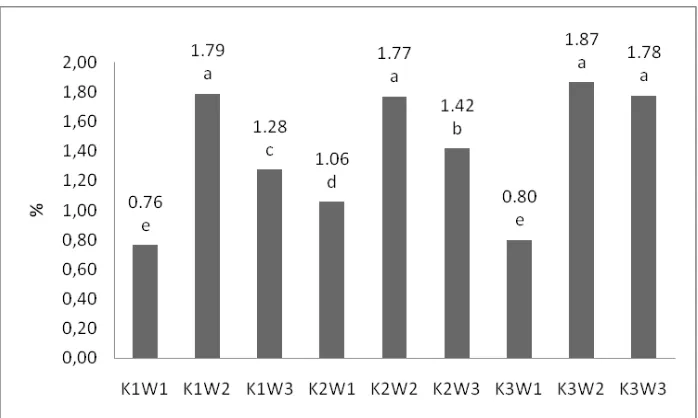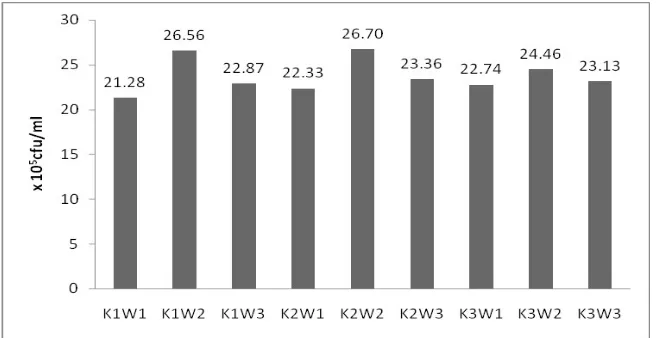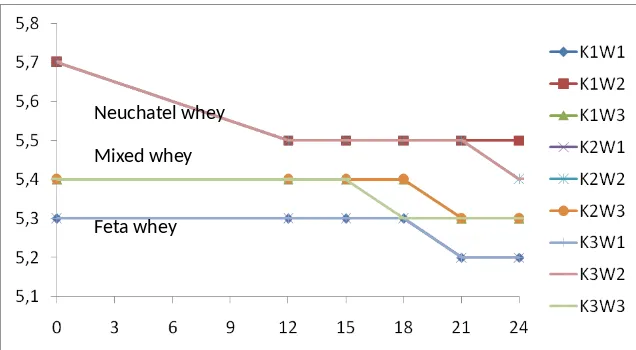THE INFLUENCE OF
Kluyveromyces lactis
CONCENTRATIONS AND WHEY TYPES ON BIOETHANOL
PRODUCTION
Roostita L. B., Udju, D.R., Ellin H., Gemilang, L. U. Faculty of Animal Husbandry University of Padjadjaran
West Java - Indonesia
Abstract
Whey as a byproduct of cheese-making process should be used so as not cause environmental problems. Whey can be used by Kluyveromyces lactis as a raw material of ethanol production. The research was aimed to determine appropriate Kluyveromyces lactis
concentration and whey types needed to get the best bioethanol production. Research was done experimentally by using Completely Randomized Design 3 x 3 with factorial patterns. Treatments consisted of two factors, namely the addition of different
Kluyveromyces lactis concentrations (5%, 10% and 15% v/v) and combination of whey types (neufchatel whey, feta whey and mixed neufchatel and feta whey 1:1), with three replications. The result showed that 5% concentration of Kluyveromyces lactis on neufchatel whey produce 1.79% bioethanol content as best ethanol content with total yeast population was 26.56 105cfu/ml.
Keywords : Kluyveromyces lactis, whey, ethanol, total yeast
INTRODUCTION
Whey is a byproduct of cheese making process. Whey is the watery portion or serum that separates from the curds during conventional cheese making (Roostita and Fleet, 1996a). Low pH and whey nutrition content will cause problems if it is disposed directly into environment. Whey should be used so as not to cause environmental problems.
The composition of whey will be influenced by the types of cheese produced. Whey from feta cheese was high in protein and low fat. Whey produced from neufchatel cheese had higher levels of fat and protein are low enough. If compared, neufchatel whey has a higher fat but lower protein content from feta whey. In addition to fat and protein, whey still has important nutrients that can be utilized. The important nutrient is carbohydrates in the form of lactose as much as 4.8 to 5% (Ghaly, 2000). Several important nutrient contents of whey can still be used as a source of energy for living things such as microorganisms.
Kluyveromyces lactis is used in many industrial activities because of its ability to produce the -galactosidase which is higher than with other yeasts and have different metabolic stages after pyruvic acid produced (Rech et al., 1999; Moeini et al., 2004).
Pyruvic acid, became the most important branching point in Kluyveromyces lactis
metabolism. In limited oxygen condition, the oxidation of NADH can not be perfect so happens that ethanol fermentation were done through pyruvat decarboxylation into acetaldehyde which subsequently experienced reforms to ethanol (Breunig and Steensma, 2003). That is why this type of yeast can synthesize lactose into bioethanol. As revealed by Oreopoulo and Russ (2007), Kluyveromyces lactis is one of the best ethanol-producing yeasts that can produce bioethanol 0.5 g from 1 g lactose.
The use of starter concentration in the production of bioethanol varies greatly depending on the types of raw materials and fermentation conditions. The use of
Kluyveromyces lactis as starter will needed 33 ºC fermentation temperature as the optimal temperature for growth (Breunig and Steensma, 2003). Appropriate Kluyveromyces lactis
concentration and whey types needed to get the best bioethanol production.
MATERIAL AND METHODS
Research was done experimentally by using Completely Randomized Design (CRD) 3 x 3 factorial pattern, consisting of two factors: Kluyveromyces lactis
concentration of 5, 10, 15% (v/v) and the combination of whey type : feta (pH 5.3), neufchatel (pH 5.8) and mix 1: 1 feta and neufchatel (pH 5.5), with three replications. Raw materials were prepared and heated at 90°C for 15 minutes, and then fermented with various concentrations K.lactis at a temperature of 33 °C for 24 hours on anaerobic container without agitation. After that, bioethanol content was calculated using brix method and total yeasts population were counted by spread inoculation of 0.1 ml of dilution over the surface of plates of Glucose Yeast Extract Agar (GYEA). The results were analyzed by analysis of variance followed by Duncan test.
RESULTS AND DISCUSSIONS Bioethanol Contents
The influence of Kluyveromyces lactis concentrations and whey types on bioethanol content showed in Figure 1. Figure 1 showed that whey type giving significant effect on bioethanol contents. It is caused by the difference of nutritional composition on each types of whey which is lactose as main nutrients on bioethanol production (Ghaly, et al., 1993; Roostita and Fleet, 1996b; Maullu, et al., 1999). High amount of lactose in substrates does not always give high production of bioethanol. Bioethanol production were not affected by high amount of lactose, but more influenced by the amount of glucose and galactose derived from lactose hydrolysis
K1 = K.lactis concentration of 5 %, K2= K.lactis concentration of10 %, K3 = K.lactis concentration of15 %,
W1 = feta whey, W2 = neufchatel whey, W3= Mixed 1 : 1 feta and neufchatel whey, different letters on bars
indicate significantly different.
Figure 1. The Influence of K.Lactis Concentrations and Whey Types on Bioethanol Contents
The research proved that whey feta which has a higher amount of lactose than whey neufchatel, were produce lowest bioethanol. In contrast, neufchatel whey which has a lower initial amount of lactose, resulting in a higher bioethanol. The low production of bioethanol is not only due to the nutritional composition of the substrate but is also influenced by pH, incubation time, and also the amount of glucose and galactose that available on the substrates (Ramakrishnan and Hartley, 1993; Kargi, et al., 2006; Dagbagli and Goksungur, 2008). As revealed by Sansonetti, et al. (2010), bioethanol contents and yeasts growth were more influenced by the pH of whey.
Kargi, et al., (2006) states that pH 5-6 is the optimum pH to produce bioethanol with whey as raw material. As mentioned by Neri, et al. (2008) at pH 5.0 to 5.5 -galactosidase produced by K.lactis through an adaptation phase and has a low activity. The
-galactosidase activity increased as the increasing of pH and then through the exponential phase at pH 5.5 to 6.0 and reached a peak at pH 6.5. Thus the amount of glucose and galactose which can be hydrolyzed in the feta and mixed whey (pH < 5.5) to be not optimal, so at 24 h there will be a shortage of glucose and the production of bioethanol will be low. In line with Ramakrishnan and Hartley (1993) that showed in the first 24 hours
K.lactis only utilize glucose and then will break down galactose to produce bioethanol. However, whey neufchatel which has a pH of 5.7 which is the pH where -galactosidase activity experiencing exponential phase as described Neri, et al. (2008). Therefore, the amount of glucose and galactose which can be hydrolyzed would be better than whey feta and thus produced higher bioethanol contents.
produced from each type of whey has increased along with increasing levels of K.lactis
concentration. However, the addition of 15% concentration K.lactis in whey feta (K3W1), produce lower bioethanol contents than the addition of 10% K.lactis concentration (K2W1). This allegedly caused by the low amount of glucose which can be hydrolyzed from lactose. The high number of K.lactis were added resulted in higher competition for the available glucose so that glucose will be depleted and used only for respiration , so the shortage of glucose lead to the low amount of bioethanol contents.
The low bioethanol contents allegedly due to the Crabtree negative properties owned K.lactis. Breunig and Steensma (2003) mentions that K.lactis Crabtree negative occur when the substrate has a low glucose and oxygen were limited, this causes the respiration dominates K.lactis metabolic pathway and resulted in low bioethanol contents.
The research has shown that whey neufchatel (W2) with 5% level of K.lactis
concentration (K1W2) can be summed up as the best treatment in producing bioethanol. This treatment is taken as the best treatment because the lowest concentration of 5%
K.lactis can produce bioethanol content of 1.79% which was not significantly different compared to other treatments that use a higher K.lactis concentration.
The Yeast Populations
K1 = K.lactis concentration of 5 %, K2= K.lactis concentration of10 %, K3 = K.lactis concentration of15 %,
W1 = feta whey, W2 = neufchatel whey, W3= Mixed 1 : 1 feta and neufchatel whey
Figure 2. The Influence of K.Lactis Concentrations and Whey Types on Yeast Populations
The results (Figure 2) showed that whey neufchatel (W2) fermented with 10% level of K.lactis concentration (K2W2) give the highest yeast population (26.70 x 105 cfu/ml). Whey neufchatel (W2) shown as the better raw material with highest yeasts population of 24.46 – 26.70 x 105 cfu/ml.
lactis growth fast, as revealed by Breunig and Steensma (2003), Kluyveromyces lactis
experiencing exponential growth at 8h till 16h at a temperature of 30-35 ºC. Meanwhile the pH of whey give different effects on yeast populations. Feta and mixed whey which has pH < 5.5 give lower yeast populations, while neufchatel whey which has a pH of 5.7 give a higher yeast populations. This is alleged to be caused by the amount of glucose and galactose which can be hydrolyzed from lactose that can be utilized as an energy source for growth and cleave. As revelaed by Neri, et al. (2008), the activity of -galactosidase was low on pH under 5.5. Therefore, the amount of hydrolyzed glucose and galactose which can utilize would be better on neufchatel whey (pH 5.7) and thus yeast populations were higher.
Kluyveromyces lactis concentrations were also affect the total population of yeast that growth on whey. The increase of Kluyveromyces lactis concentrations until 10% followed by the increasing of yeast populations, while the increase of concentration until 15% caused population decrease. In line with Phowchinda, et al., (2010) that revealed the increase of inoculum level was decreased the viability of yeast population at the end of fermentation, using too high concentration of inoculum may reduce the viability of selected strain.
pH
K1 = K.lactis concentration of 5 %, K2= K.lactis concentration of10 %, K3 = K.lactis concentration of15 %,
W1 = feta whey, W2 = neufchatel whey, W3= Mixed 1 : 1 feta and neufchatel whey
Figure 3. The Influence of K.Lactis Concentrations and Whey Types on pH
Low pH will limit yeasts growth (Fleet, 1998), so that Kluyveromyces lactis takes more time to utilize lactose on lower pH (5.3-5.4). Figure 3 shown on the first 12h the pH of neufchatel whey were decrease, different with pH of mixed and feta whey which decrease at 15h and 18h. High amount of hydrolyzed glucose that utilized into organic acid, will cause rapid pH decrease on first 12h at neufchatel whey. While on mixed and feta whey, lower pH cause slower activity of -galactosidase. It will cause a lower
Neuchatel whey
Mixed whey
hydrolized glucose and slower production of organic acid, moreover the decrease of pH will occure slowly.
CONCLUSIONS
Kluyveromyces lactis concentration of 5% which added on whey neufchatel give the best bioethanol content of 1.79% with the total yeast population was 26.56 105cfu/ml. The increase of K.lactis concentration until 10% caused bioethanol contents and total yeast population increase, but 15% Kluyveromyces lactis concentration will caused decrease of bioethanol contents and total yeast population. Optimalisation of pH and lactose addition were need to increase bioethanol contents.
ACKNOWLEDGEMENTS
Author would like to thanks PT. Yummy Food Utama, Mrs. Enny, Dadan Surya Kusuma and Arief Rusfian Ghani which has helped and facilitated author, so that the research can be accomplished.
REFERENCES
Breunig, K.D. and Yde Steensma, H. 2003. Kluyveromyces lactis : Genetics, Physiology and Application. Dalam J.H. de Winde (Ed.). Functional Genetics of Industrial Yeasts. Springer-Verlag Berlin Heidelberg.
Bylund, G. 1995. Dairy Processing Handbook. Tetra Pak Processing System AB. Lund. Swedia.
Dagbagli, S. and Goksungur, Y. 2008. Optimization of Β-Galactosidase Production Using Kluyveromyces Lactis NRRL Y-8279 by Response Surface Methodology. Electronic Journal of Biotechnology 11 (4).
Fleet, G.H. 1998. The Microbiology of Alcoholic Beverages. In Wood, B.J.B.
Microbiology of Fermented Foods. Blackie Academic and Professional. London. Ghaly, A.E. and E.A. Echiegu. 1993. Kinetic of A Continuous Flow No-Mix Anaerobic
Reactor. Energy Sources 15(3) : 1-17.
Ghaly, A.E., D.R. Ramkumar, S.S. Sadaka and J.D. Rochon. 2000. Effect of Reseeding and pH Control on the Performance of a Two-Stage Mesophilic Anaerobic Digester Operating on Acid Cheese Whey. Journal of Canadian Agricultural Engineering 42(4) : 173-183.
Kargi., F and Omzichi, S. 2006. Utilization of Cheese Whey Powder (CWP) for Ethanol Fermentations: Effects of Operating Parameters. Enzyme and Microbial Technology 38 : 711–718.
Maullu, C., Lampis, G., Basile, T., Ingianni, A., Rossolini, G.M., Pompei, R. 1999.
Production of lysozymeenriched biomass from cheese industry by-products. Journal of Applied Microbiology 86:182-186.
Moeini, H., Nahvi, I., Tavassoli, M. 2004. Improvement of SCP production and BOD removal of whey with mixed yeast culture. Elec. J. of Biot. 3 : 251 – 255.
polysiloxane–polyvinyl Alcohol Magnetic (mPOS–PVA) Composite for Lactose Hydrolysis. Catalysis Communications 9 : 2334–2339.
Oreopoulou, V and Russ, W. 2007 Utilization of By-Products and Treatment of Waste in the Food Industry. Springer Publisher.
Phowchinda, O., Delia-Dupuy, M.L., and Streihaiano, P. 2010. Alcoholic Fermentation from Sweet Sorghum : Some Operating Problems. Thru, <http://www.thaiscience.info/>[29/03/2010]
Ramakhrishnan, S. and Hartley, B.S. 1993. Fermentation of Lactose by Yeast Cells Secreting Recombinant Fungal Lactase. Journal of Applied and Environmental Microbiology. 59 (12) : 4230 – 4235.
Rech, R., Cassini, C.F., Secchi, A. and Ayub, M.A.Z. Utilization of protein-hydrolyzed cheese whey for production of b-galactosidase by Kluyveromyces marxianus. Journal of Industrial Microbiology and Biotechnology. 23(2) : 91-93.
Roostita R. and Fleet, G.H., 1996a. Occurrence, Growth and Biochemical Properties of Yeasts in Cheese and Milk. International Journal of Food Microbiology, vol. 28, p. 393-404.
Roostita, R. and Fleet, G.H. 1996b. Growth of Yeasts in Milk and Associated Changes to Milk Composition. International Journal of Food Microbiology, 1996, vol. 31, p. 205-219.


